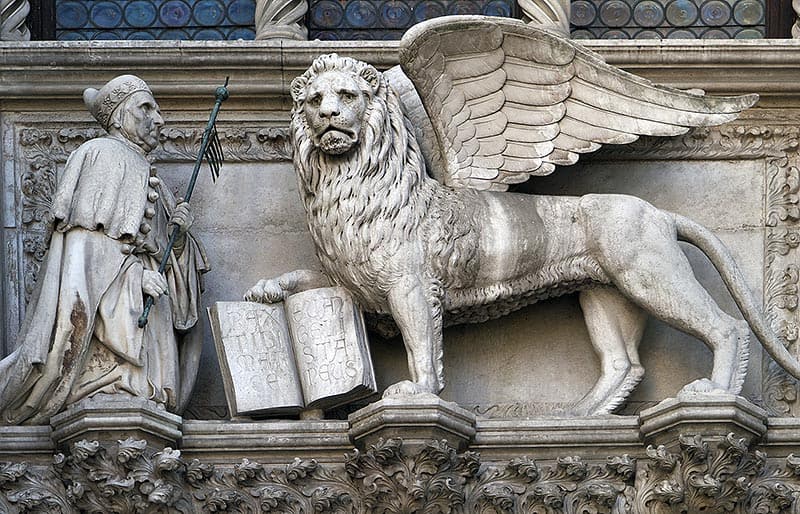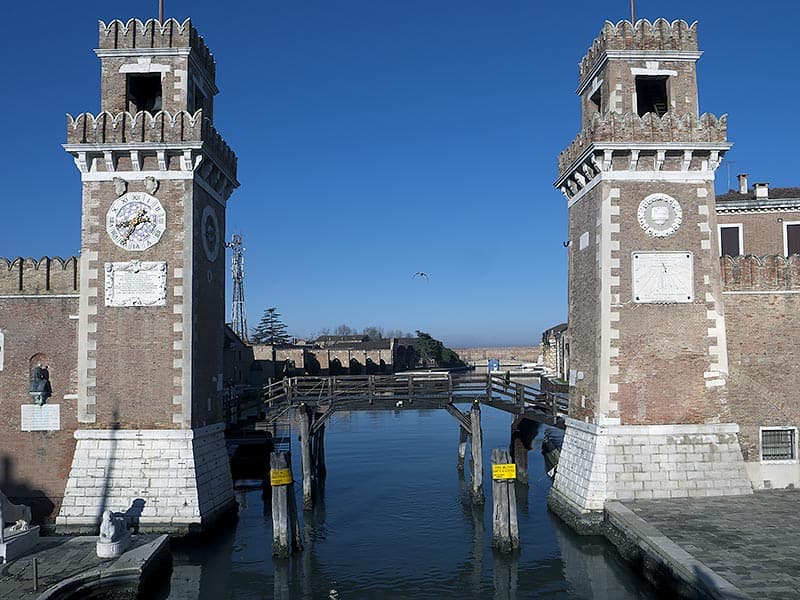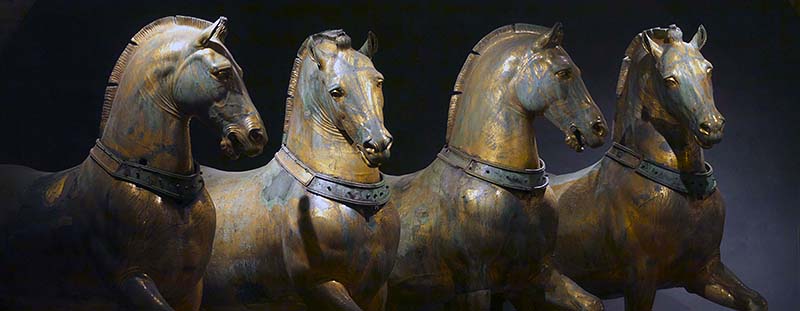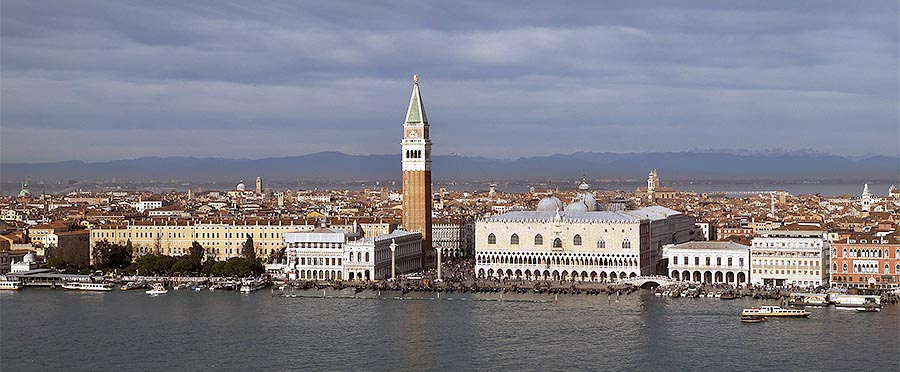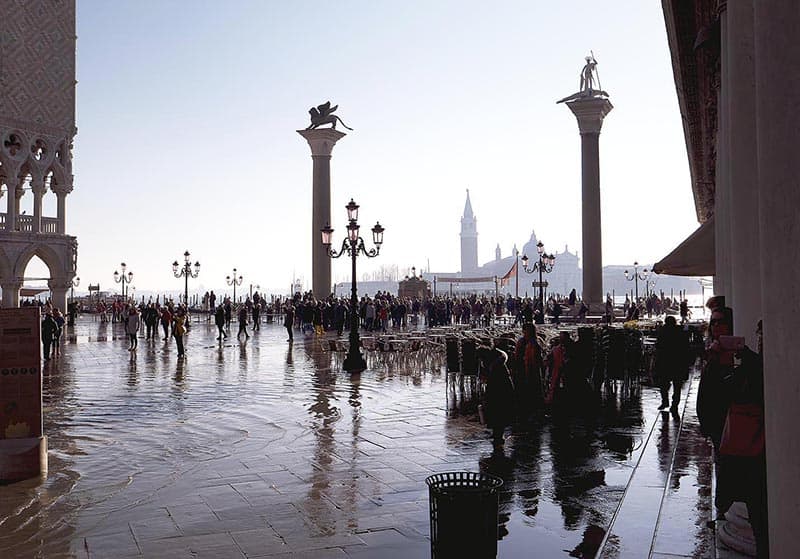The History of Venice
The History of Venice. When the Lombard’s invade Italy in 568, one of the first cities in their path is Aquileia – a Christian town of long-standing importance, traditionally held to have been founded by St Mark.
Many of its inhabitants, alarmed at the prospects of life under the rule of Germanic tribesmen, opt for the uncertain status of refugees. Fleeing southwards, some seek safety on the low-lying offshore island of Torcello – probably occupied at the time only by a fishing community.
The refugees, seen with the hindsight of history, are the founders of Venice.
Less than twenty years later, in about 584, those parts of the east Italian coast still in Byzantine hands are grouped together as the exarchate of Ravenna – a defensive arrangement against the Lombards. The islanders of Torcello, who have perhaps already spread to neighbouring islands in the Venetian lagoon, are included in the exarchate. But with the northern mainland in Lombard hands, and with a considerable distance separating them from the centre of Byzantine government at Ravenna, their survival is largely in their own hands. They become increasingly independent.
In 726, the Venetians for the first time elect their own doge (the equivalent of ‘duke’, from the Latin dux meaning ‘leader’)
History of Venice: Doges and diplomacy: AD 726-814
Orso, the first Venetian doge, comes to power specifically as an opponent of Byzantine rule over the islands of the lagoon. This first bid for independence fails. Byzantine officials continue to govern the islands until the fall of the exarchate of Ravenna in 751. The Venetians, now of necessity on their own though still legally subject to the Byzantine empire, develop skills as middlemen which eventually bring them great wealth and power.
When Pepin, the son of Charlemagne, campaigns in northeast Italy in 809, the Venetian doge makes an alliance with him – a move involving considerable risk, in that it is unlikely to please the Byzantine emperor.
Others might be crushed between the new Carolingian empire to the west and the ancient Byzantine Empire in the east. However, Venice successfully plays the giants off against each other and thrives. A treaty in 814 between the Franks and the Byzantines establishes that Venice is to remain independent of the Carolingian empire, but no special emphasis is laid on the existing obligation to Constantinople.
As part of both eastern and western worlds and perfectly placed between the Mediterranean and mountain passes up through the Alps into northern Europe, Venice is now poised to make her fortune from trade.
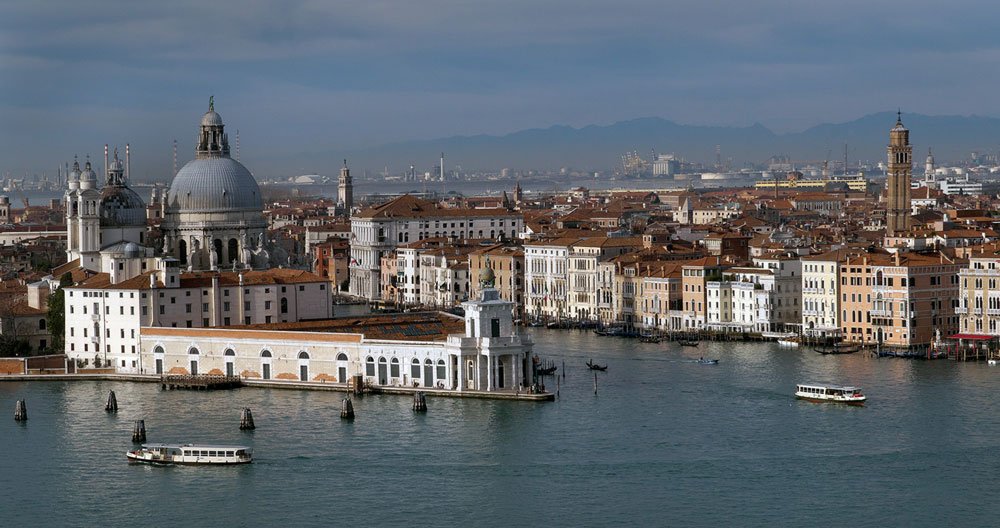
Rialto and St Mark’s: 9th – 11th century AD
Early in the 9th century the government of the lagoon is transferred to two adjacent islands where the land is a little higher above water level, an area known as rivo alto (high bank), from which the name Rialto derives. The Rialto Bridge subsequently joins these two banks.
The growing town needs status. In the Christian Middle Ages status requires a distinguished patron saint and if possible, the possession of his relics. St Mark, the patron saint of Aquileia (in effect the parent city) is the obvious candidate. In about 828 Venice comes of age. The city acquires, from Alexandria, some relics of St Mark.
Legend rapidly provides exciting details of how the bones were secured. It is said that two Venetian merchants stole them from the saint’s shrine in Alexandria and then smuggled them out of Egypt in a barrel of pork – an unclean meat to Muslims and therefore unlikely to be inspected.
Whatever the actual means (theft of relics is common in the Middle Ages, but purchase is equally possible), the arrival of the bones is the occasion for the building of the first St Mark’s in Venice. The church, rebuilt in the 11th century and subsequently enlarged and altered, has been ever since the proud centrepiece of the city.
Eastern trade: 11th – 14th century
Two developments in the 11th century prove of lasting benefit to Venice, which is by now the leading maritime power in the Adriatic. The first is the appearance of a rival in Italian waters. The Normans drive the Byzantines from their last seaport in southern Italy by 1071, and soon they begin raiding across the Adriatic; in 1082 they take the important harbour of Durrës (or Durazzo) in Albania.
In return for help against these marauders, the Byzantine emperor grants Venice an astonishing concession. Venetians may henceforth trade freely throughout the Byzantine Empire, without being liable for any dues or customs.
The other new development of the late 11th century opens up extra routes for trade, along the coasts of the Byzantine Empire and beyond. In 1096 the contingents of the First Crusade set off eastwards to recover the holy places of Christendom from the Muslims. They are in Syria by 1098. By the end of 1099 there is a Latin kingdom of Jerusalem.
A great increase in trade, travel and pilgrimage to the eastern Mediterranean is the inevitable result. Venice, which has the skills to provide the transport and an already established trade concession, is once again perfectly placed. But it soon meets strong rivalry from two other great maritime communes, Genoa and Pisa.
The Italian communes of the west coast demonstrate their strength in the 11th century when Genoan and Pisan fleets, often working in alliance, protect Corsica and Sardinia from the depredations of Muslims. Both cities subsequently develop extensive trade in the western Mediterranean. Genoa also plays a large part in the crusades, establishing strong trading links in the eastern Mediterranean and coming into direct competition with Venice.
Warfare between these two Italian city states is long and intermittent, with Venice by no means always the stronger – until the issue is finally resolved in 1380 at Chioggia.
Venetian mosaics: 12th – 13th century AD
Venice’s long link with Constantinople is evident in the mosaics, in the Byzantine style, for which the islands of the lagoon are famous. The earliest are on Torcello, the first centre of the Venetian state, where the cathedral apse contains a superb 13th-century image of the Virgin and Child.
The entire west wall of the cathedral is occupied by a vast mosaic of the same period depicting the Last Judgement. The subject is more characteristic of the western church than of Byzantium, as is the somewhat radical manner in which figures of authority are prominently displayed among the damned – including the Byzantine emperor, the Venetian doge and the German emperor.
When the Torcello mosaics are being installed, this cathedral is no longer the most important one in the Venetian lagoon. That honour has passed to St Mark’s, where craftsmen in mosaic are busy at the same period. Their labours produce probably the most sumptuous church interior in the world, with every corner a sombre glittering gold. It has been calculated that the mosaics of St Mark’s cover an area of about an acre.
Dating mainly from the 12th and 13th centuries, these Italian mosaics represent the culmination of a great Byzantine tradition. But at the end of the 13th century Italy also provides a new beginning in an equally great theme in the history of art – that of the European fresco.
The Pala d’Oro: 10th – 14th century AD
In addition to its Byzantine mosaics, St Mark’s contains in the Pala d’Oro the most spectacular surviving altarpiece of a kind familiar in imperial Byzantine churches. Small scenes in cloisonné enamel of Jesus, the Virgin and saints are set in a gold background encrusted with jewels. Commissioned from the workshops of Constantinople by a doge of the 10th century, the original Pala d’Oro is dismantled and extended several times to incorporate new panels. It acquires its present form in 1345.
Some of the added panels are brought here from Constantinople in 1204, among the loot which greatly enriches Venice as a result of the shameful episode of the fourth crusade.
Venice as a commune: 12th – 18th century AD
From the circumstances of its foundation, Venice has been from the start unique – a small self-governing community of refugees which grows rich on its own audacious merits. But in the 12th century other north Italian cities adopt a communal form of government, similar to what Venice has always had.
Venice, at the same period, takes steps to preserve its republican identity. Reforms are put in place to ensure that the position of the doge (who holds office, like the pope, until death) cannot evolve into that of a hereditary signore – as will subsequently happen in other Italian communes.
In various stages between 1140 and 1160 the government of Venice (which now includes Venetian colonies along the Dalmatian coast) is removed from the sole personal responsibility of the doge and is transferred to powerful councils. The supreme body is the Great Council of 45 members, with ultimate responsibility for state affairs. On day-to-day matters an executive Minor Council of six members is appointed to guide the doge.
Over the years Venice’s councils grow and proliferate.
During the 13th century the Great Council expands from 45 members to 60 and then 100. A new Council of Forty is added at some time before 1223, followed by another body of 60 members with special responsibility for financial affairs; this is the Consiglio dei Rogati, known also as the Senate. A Council of Ten is added in 1310, to check on everybody else.
The doge, richly attired and publicly honoured, is a powerless figurehead at the centre of this state administration. The system is brilliantly devised to preserve the status quo in two ways – preventing the present doge’s family from acquiring power and preventing the wider group of patrician families from losing it.
The doge is not allowed to engage in trade or any financial activity. No member of his family may hold office in government or serve on the councils. Safeguards are in place to prevent an election being rigged (the final group of electors is chosen by lot). Thus, the graft and nepotism which disfigures the papacy is ruled out for the doges of Venice.
Similarly, stringent measures are introduced to prevent outsiders getting in. Between 1290 and 1300 the so-called ‘closing of the Great Council’ limits membership to those families which have provided members in the past. Oligarchy is thus enshrined, in a system which survives until the French Revolution. Rarely has power been so successfully ring-fenced for so long.
The crusaders camp outside Constantinople while Alexius, as emperor, tries to raise his debt to The Venetians by taxing the citizens and confiscating church property. For nine months growing resentment within the city is matched by increasing impatience outside. In April the Venetians persuade the crusaders to storm Constantinople and place a Latin emperor on the throne. For the second time they succeed in breaching the walls. The doge of Venice and the leading Crusaders install themselves in the royal palace. The army is granted three days in which to pillage the city. The Venetians, from their long links with Constantinople, can appreciate the Treasures of Byzantium. They loot rather than destroy. St Mark’s in Venice is graced today by many rich possessions brought back in 1204 – parts of the Pala d’Oro, the porphyry figures known as the tetrarchs, and above all the four great bronze horses.
The crusaders, mainly French and Flemish, are less refined in their tastes. They tend to smash what they find. They ride their horses into Santa Sophia, tear down its silken hangings, and destroy the icons in the silver iconostasis. A prostitute, placed on the patriarch’s throne, obligingly sings a bawdy song in Norman French.
Venice’s maritime empire: 13th – 15th century AD
In the scramble to grab Byzantine land after the fourth crusade, in 1204, the Venetians concentrate on territories suiting their maritime interests. They take the islands of Corfu and Crete.
They yield Corfu ten years later to the Greek ruler of Epirus (the nearest part of the mainland), but Crete remains a Venetian possession for more than four centuries. It is the first in a chain of valuable staging posts to the eastern Mediterranean. Venetian control over Cephalonia is established in 1350. In 1380, at Chioggia, Venice finally defeats Genoa and becomes the undisputed maritime power in eastern waters. The other links in the island chain to the east are acquired during the following century.
Corfu is recovered in 1401. The Dalmatian coast is ceded to Venice by the king of Croatia in 1420. Zante is acquired in 1482. Finally, Cyprus the jewel at the end of the chain, is annexed in 1489.
This is precisely the period during which the Ottoman Turks have been winning control of the mainland facing these Mediterranean islands, from Anatolia to the Balkans. Constantinople falls to them in 1453; Greece is in Turkish hands by 1460. For the next two centuries the Venetians in the islands confront the Turks on the mainland in a struggle which the Turks ultimately win. Meanwhile the Venetians have been establishing an extensive realm in their own backyard.
Venice and the Veneto: 14th – 15th century AD
While the Venetians are acquiring islands on the route to the Middle East, they also gain control of a large part of the Italian mainland. The first territory to be won is the region adjacent to their own lagoon – the Veneto (named like Venice itself from an Indo-European tribe, the Veneti, who migrated here in about 1000 BC).
Venice occupies these mainland territories by force. But the Venetian role is that of the jackal coming in after the lion.
The lion in northern Italy in the late 14th century is Gian Galeazzo Visconti, the signore of Milan. Gian Galeazzo is a voracious conqueror, suspected in his own time of harbouring the ambition to become king of all Italy. He systematically seizes the territories of lesser signori. Those lying between Milan and Venice include Verona and Vicenza, two cities ruled by the della Scala family (known also as Scaliger in the Latin version of their name).
Vicenza falls to Gian Galeazzo in 1384 and Verona in 1387. His next target is Padua, ruled by the Carrara family, which he takes in 1388.
Padua is recovered for the Carrara in 1390 with Venetian help, but its long-term independence looks unlikely as Gian Galeazzo’s realm continues to expand. Pisa and Siena accept his rule in 1399; he captures Bologna in 1402; but later that year, as he is preparing to attack Florence, he dies suddenly of the plague.
The rapidly enlarged Visconti realm crumbles on Gian Galeazzo’s death, and Venice is on hand to pick up some of the pieces. Vicenza is captured in 1404, followed by Verona and Padua in 1405. A generation later, with the Veneto now securely Venetian, the republic’s territory is further enlarged to north and west.
Heyday of the republic: 15th – 16th century AD
In the 1420s Venice extends its territory on the Italian mainland to give it an unbroken stretch of rich land south of the Alps, from the northern tip of the Adriatic almost to Milan. The northern extension is the first to be secured. In 1420 Venice conquers the region of Friuli, ancient lands of the patriarch of Aquileia – from whose cathedral city the first Venetians had fled nearly nine centuries earlier.
A few years later Brescia is captured (1426) followed by Bergamo (1428), gains from Milan which are acknowledged in the peace of Lodi (1454). With this rich hinterland, and a string of Mediterranean islands all the way to Cyprus, Venice is now a Mediterranean power of exceptional splendour.
Yet at this very moment there is a worm in the bud. With the new ocean trade resulting from the discovery of America and of the sea route to India, ocean-going vessels are set to become of greater economic significance than the Mediterranean galleys which have held sway for three millennia. Venice in her prime is about to be side-lined.
But her prime is magnificent. In the 15th century Venice provides the last great flowering of Gothic architecture. By 1500 the city leads the world in its printing skills. In the 16th century Venetian culture produces Europe’s leading architect of the period (Palladio) and an outstanding school of regional painting.
The Italian bran tub: AD 1499-1512
During the first three decades of the 16th century Italy is the scene of almost ceaseless warfare between local contenders (particularly Venice and the papacy) and foreign claimants (France and Spain), with occasional interventions from north of the Alps by Habsburgs and by armies from the Swiss cantons.
The Italian adventures of the French king Charles VIII are continued by Louis XII, his cousin and successor. To the long-standing French claim to Naples, Louis adds a new demand – he believes himself to be duke of Milan, by descent from his Visconti grandmother.
French armies seize Milan for Louis XII in 1499, and the French occupy part of the kingdom of Naples in 1501. The Spanish soon recover full control of Naples (by 1504), but the presence of the French in Milan causes an ambitious new pope, Julius II, to intervene in the unstable affairs of northern Italy. He marches north and captures Bologna in 1506.
Julius believes Venice and the French to be the two main threats to the papal states of central Italy. With ruthless diplomatic skill he organizes two different alignments of the principal players, to deal with each of his enemies in turn.
The pope forms first the league of Cambrai, in 1508, in which he persuades France, Spain and the Austrian Habsburgs to join him against Venice. The Venetians are defeated at Agnadello in 1509, after which Julius and the Habsburgs appropriate much of Venice’s mainland territory.
With this achieved the pope moves on to his second objective. He organizes the Holy League of 1511. Again, there is a single enemy, but this time it is France. Venice, recently humbled, is enrolled with Spain and the Habsburgs on the papal side; and there is useful support from the Swiss, now considered Europe’s most formidable fighters. Even Henry VIII of England joins in, at a distance.
In 1512 a joint army of papal, Spanish and Venetian forces weakens the French in a battle near Ravenna, after which the Swiss are able to sweep through Lombardy and drive the intruders from Milan.
At this stage Venice and France are the clear losers. But this has only been round one. In the next bout, the contest becomes much more clearly a clash between Spain and France – and in particular a personal rivalry between two young kings. Francis inherits the throne of France in 1515. Charles, a Hapsburg, becomes king of Spain in the following year on the death of Ferdinand II.
Italian realignment: AD 1508-1540
A series of shifting alliances, often brokered by the papacy and ending in inconclusive battles, redraws the map of Italy during the first decades of the 16th century.
Between the league of Cambrai (1508) and the treaty of Cambrai (1529), the territories of Milan, Venice, the Papal States and Naples grow or shrink, and abruptly suffer changes of allegiance, according to the temporary effects of battles such as Agnadello (1509), Marignano (1515), Pavia (1525) and the sack of Rome by imperial troops in 1527.
Among the Italian players in this board game, the Medici are among those who gain – being restored, with Spanish support, to their rule in Florence. Venice, an early loser when alone against all the others in 1508, later recovers most of its territory and retains its independence.
The papacy, responsible for the scheming alliances which foster so much of the conflict, appears to receive its just deserts in the sack of Rome in 1527. But it too emerges much strengthened a decade or two later. Once the Catholic Reformation is under way, Rome and Spain – allies in spiritual severity – are well equipped to exercise strict control over the entire peninsula apart from republican Venice.
Venetian decline: 16th – 18th century AD
After the Italian turmoil of the early 16th century, Venice enters a long and gradual period of decline. This is in no way diminishes the artistic brilliance of the city. The Venetian school of the 16th century includes Giorgione, Titian, Veronese and Tintoretto; two centuries later Venice is home to Tiepolo, Canaletto and Guardi. But politically the great days are over.
This is evident in the fact that the republic, once so pugnacious, maintains cautious neutrality from the mid-16th century onwards. Venice now fights only to defend its Mediterranean possessions from the Turks. In the long run, even this proves a hopeless battle.
At first the omens seem good on the Mediterranean front. The Turkish invasion of Cyprus in 1570 prompts a vigorous Christian response. A joint Spanish and Venetian fleet, defeats the Turks decisively at Lepanto in 1571; but it proves a hollow victory. Only two years later, in 1573, Venice cedes the island to Turkey. A century later, in 1669, the Turks finally evict the Venetians from another great prize, Crete.
Of the island staging posts to the east, so carefully accumulated by Venice, only the Ionian group of islands (including Corfu, Cephalonia and Zante) escapes Turkish encroachment.
Losing its political will, Venice finds the new role which it has enjoyed ever since – as a place of pleasure and delight, Europe’s most sparkling tourist attraction. The city has the world’s first public opera house, which opens in 1637. It has the pageantry seen in Canaletto, the titillating tradition of masked women who feature in paintings by Longhi, the social comedy of the plays of Goldoni.
This city of canals is an irresistible part of the fashionable Grand Tour. And it remains, under its doddery oligarchy of doge and senate, an independent republic – until the brusque intrusion of Napoleon in 1797.
Austrian and Italian Venice: AD 1797-1866
Napoleon, campaigning against Austria in Italy in 1797, deposes the last doge. By the treaty of Campo Formio, later in the same year, Venice and the Veneto are handed over to Austria.
Venice remains under Austrian rule until 1866, when Austria is defeated in the Seven Weeks’ War. Venice and the Veneto (often collectively known as Venetia) are ceded to the newly independent kingdom of Italy. The ancient city becomes, as it remains today, the capital of the province of Venezia.
LINKS (external–internal)
Two interesting You Tube videos
The Reason Why Venice Is Built On Water | Blowing Up History
See my other posts in the category of”History of Venice”
“Political Empire through Trade”
The History of Venice The History of Venice The History of Venice
The History of Venice The History of Venice The History of Venice
The History of Venice The History of Venice The History of Venice
The History of Venice The History of Venice The History of Venice

